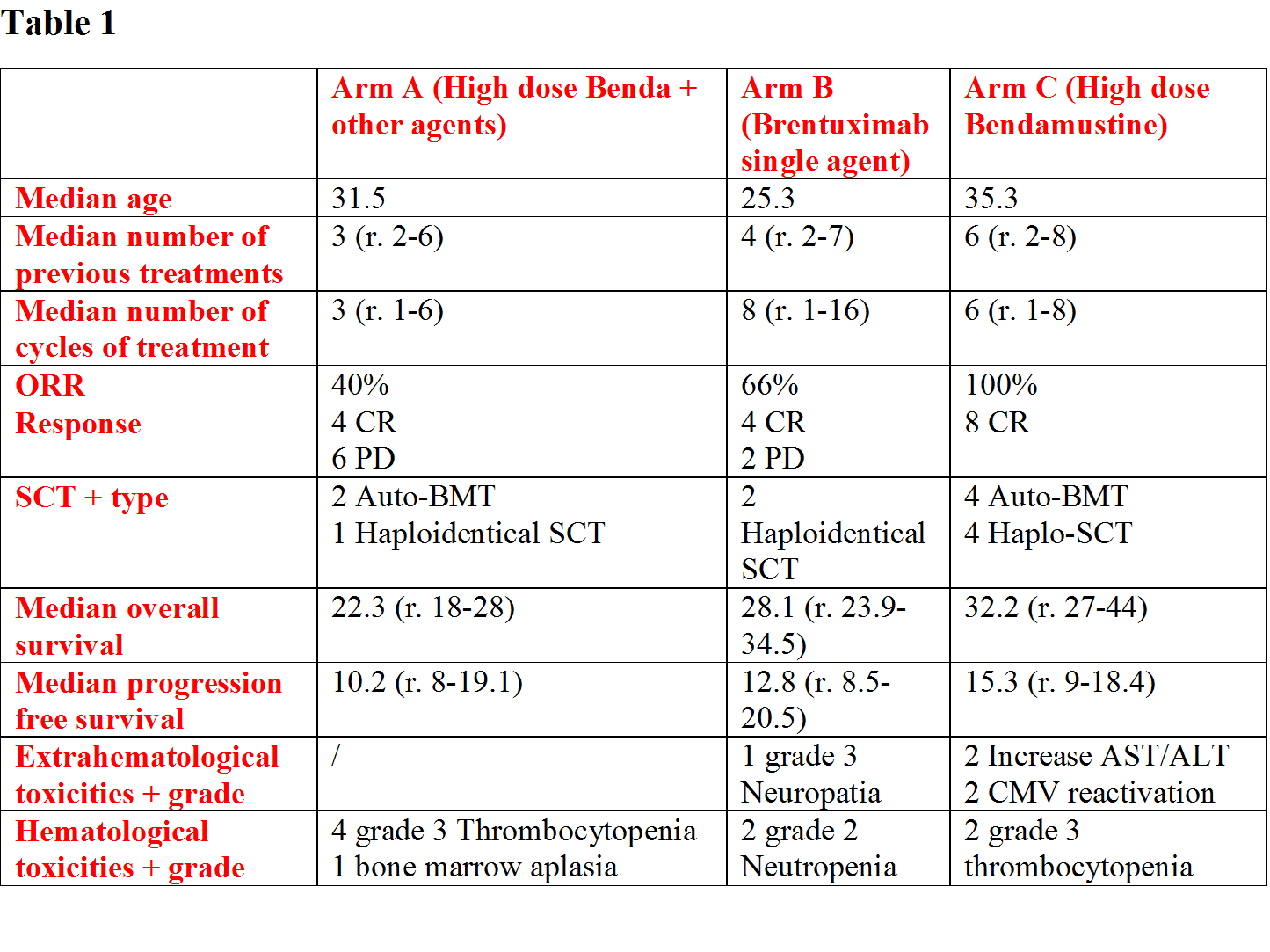BENDAMUSTINE-BRENTUXIMAB COMBINATION IS EFFECTIVE AND HAS A FAVOURABLE TOXICITY PROFILE IN THE TREATMENT OF REFRACTORY AND RELAPSED HODGKIN LYMPHOMA
(Abstract release date: 05/19/16)
EHA Library. Cerchione C. 06/09/16; 135369; LB2258

Dr. Claudio Cerchione
Contributions
Contributions
Abstract
Abstract: LB2258
Type: Eposter Presentation
Background
The management of patients with refractory or relapsed Hodkin lymphoma (HL), expecially if after autologous stem cell transplantation (ASCT) remains controversial. Bendamustine has demonstrated efficacy in several lymphoproliferative disorders but limited data are available regarding the schedule in patients with HL, in particular its dosage and the possibile combinations for a synergistic effect. Brentuximab Vedotin is a CD30-directed antibody-drug conjugate, currently approved for the treatment of relapsed or refractory Hodgkin lymphoma (HL), as single-agent at the dose of 1.8 mg/kg.
Aims
The objective of this phase II study was to evaluate efficacy and safety of salvage cytotoxic regimens in patients with refractory and/or relapsed HL. Three different schedules were evaluated.
Methods
From May 2011 to February 2016, 24 patients (13 M/11 F) (Table 1) with a median age of 32.5 years (range 16-73) received a salvage regimen after failure of ASCT. Patients were by chance assigned to one of these three arms : Standard dose Bendamustine (90 mg/sqm) days 1, 2 + DHAP x 3 cycles (Arm A), brentuximab single agent 1.8 mg/kg x 4-8 cycles (Arm B), High dose Bendamustine (120 mg/sqm, days 1, 2) + brentuximab 1.8 mg/kg (day 3) x 4-6 cycles (Arm C). Each cycle was repeated every 28 days and growth factor support was sistemically administered, in association with antimicrobial prophylaxis. The treatment efficacy in each group was evaluated according to Revised Response Criteria for Malignant Lymphoma. Any adverse event occurred was recorded and classified for type and grade using NCI-CTCAE criteria (v 4.0).
Results
In arm A, which included 10 patients, the overall response ratio was 40%, with 4 complete remission (CR) and 6 progressive disease (PD). Extra-hematological toxicities were grade 3 thrombocytopenia in 4 patients and bone marrow aplasia in 1 patient.In arm B, which included 6 patients, the overall response ratio was 66%, with 4 CR and 2 PR. Extra-hematological toxicities were grade 3 neuropathy in 1 patient, hematological toxicity was grade 2 neutropenia in 2 patients.In arm C, which included 8 patients, the overall response ratio was 100%, with 8 complete remission (CR) and then SCT (4 autologous and 4 haploidentical-SCT) with persistence of complete remission in all patients. Median overall survival was 32.2 months (r. 27-44) and median progression free survival 15.3 months (r. 9-18.4). Extra-hematological toxicities were increase of transaminase in 2 patients and CMV reactivation in 2 patients, treated successfully with valgangiclovir. Hematological toxicity was grade 3 thrombocytopenia in 2 patients.
Conclusion
High dose Bendamustine plus Brentuximab has shown significant efficacy in a particular severe setting of heavily pretreated patients, and it could be considered as a bridge to allogenic BMT.

Session topic: E-poster
Keyword(s): Allogeneic bone marrow transplant, Bendamustine, Hodgkin's lymphoma
Type: Eposter Presentation
Background
The management of patients with refractory or relapsed Hodkin lymphoma (HL), expecially if after autologous stem cell transplantation (ASCT) remains controversial. Bendamustine has demonstrated efficacy in several lymphoproliferative disorders but limited data are available regarding the schedule in patients with HL, in particular its dosage and the possibile combinations for a synergistic effect. Brentuximab Vedotin is a CD30-directed antibody-drug conjugate, currently approved for the treatment of relapsed or refractory Hodgkin lymphoma (HL), as single-agent at the dose of 1.8 mg/kg.
Aims
The objective of this phase II study was to evaluate efficacy and safety of salvage cytotoxic regimens in patients with refractory and/or relapsed HL. Three different schedules were evaluated.
Methods
From May 2011 to February 2016, 24 patients (13 M/11 F) (Table 1) with a median age of 32.5 years (range 16-73) received a salvage regimen after failure of ASCT. Patients were by chance assigned to one of these three arms : Standard dose Bendamustine (90 mg/sqm) days 1, 2 + DHAP x 3 cycles (Arm A), brentuximab single agent 1.8 mg/kg x 4-8 cycles (Arm B), High dose Bendamustine (120 mg/sqm, days 1, 2) + brentuximab 1.8 mg/kg (day 3) x 4-6 cycles (Arm C). Each cycle was repeated every 28 days and growth factor support was sistemically administered, in association with antimicrobial prophylaxis. The treatment efficacy in each group was evaluated according to Revised Response Criteria for Malignant Lymphoma. Any adverse event occurred was recorded and classified for type and grade using NCI-CTCAE criteria (v 4.0).
Results
In arm A, which included 10 patients, the overall response ratio was 40%, with 4 complete remission (CR) and 6 progressive disease (PD). Extra-hematological toxicities were grade 3 thrombocytopenia in 4 patients and bone marrow aplasia in 1 patient.In arm B, which included 6 patients, the overall response ratio was 66%, with 4 CR and 2 PR. Extra-hematological toxicities were grade 3 neuropathy in 1 patient, hematological toxicity was grade 2 neutropenia in 2 patients.In arm C, which included 8 patients, the overall response ratio was 100%, with 8 complete remission (CR) and then SCT (4 autologous and 4 haploidentical-SCT) with persistence of complete remission in all patients. Median overall survival was 32.2 months (r. 27-44) and median progression free survival 15.3 months (r. 9-18.4). Extra-hematological toxicities were increase of transaminase in 2 patients and CMV reactivation in 2 patients, treated successfully with valgangiclovir. Hematological toxicity was grade 3 thrombocytopenia in 2 patients.
Conclusion
High dose Bendamustine plus Brentuximab has shown significant efficacy in a particular severe setting of heavily pretreated patients, and it could be considered as a bridge to allogenic BMT.

Session topic: E-poster
Keyword(s): Allogeneic bone marrow transplant, Bendamustine, Hodgkin's lymphoma
Abstract: LB2258
Type: Eposter Presentation
Background
The management of patients with refractory or relapsed Hodkin lymphoma (HL), expecially if after autologous stem cell transplantation (ASCT) remains controversial. Bendamustine has demonstrated efficacy in several lymphoproliferative disorders but limited data are available regarding the schedule in patients with HL, in particular its dosage and the possibile combinations for a synergistic effect. Brentuximab Vedotin is a CD30-directed antibody-drug conjugate, currently approved for the treatment of relapsed or refractory Hodgkin lymphoma (HL), as single-agent at the dose of 1.8 mg/kg.
Aims
The objective of this phase II study was to evaluate efficacy and safety of salvage cytotoxic regimens in patients with refractory and/or relapsed HL. Three different schedules were evaluated.
Methods
From May 2011 to February 2016, 24 patients (13 M/11 F) (Table 1) with a median age of 32.5 years (range 16-73) received a salvage regimen after failure of ASCT. Patients were by chance assigned to one of these three arms : Standard dose Bendamustine (90 mg/sqm) days 1, 2 + DHAP x 3 cycles (Arm A), brentuximab single agent 1.8 mg/kg x 4-8 cycles (Arm B), High dose Bendamustine (120 mg/sqm, days 1, 2) + brentuximab 1.8 mg/kg (day 3) x 4-6 cycles (Arm C). Each cycle was repeated every 28 days and growth factor support was sistemically administered, in association with antimicrobial prophylaxis. The treatment efficacy in each group was evaluated according to Revised Response Criteria for Malignant Lymphoma. Any adverse event occurred was recorded and classified for type and grade using NCI-CTCAE criteria (v 4.0).
Results
In arm A, which included 10 patients, the overall response ratio was 40%, with 4 complete remission (CR) and 6 progressive disease (PD). Extra-hematological toxicities were grade 3 thrombocytopenia in 4 patients and bone marrow aplasia in 1 patient.In arm B, which included 6 patients, the overall response ratio was 66%, with 4 CR and 2 PR. Extra-hematological toxicities were grade 3 neuropathy in 1 patient, hematological toxicity was grade 2 neutropenia in 2 patients.In arm C, which included 8 patients, the overall response ratio was 100%, with 8 complete remission (CR) and then SCT (4 autologous and 4 haploidentical-SCT) with persistence of complete remission in all patients. Median overall survival was 32.2 months (r. 27-44) and median progression free survival 15.3 months (r. 9-18.4). Extra-hematological toxicities were increase of transaminase in 2 patients and CMV reactivation in 2 patients, treated successfully with valgangiclovir. Hematological toxicity was grade 3 thrombocytopenia in 2 patients.
Conclusion
High dose Bendamustine plus Brentuximab has shown significant efficacy in a particular severe setting of heavily pretreated patients, and it could be considered as a bridge to allogenic BMT.

Session topic: E-poster
Keyword(s): Allogeneic bone marrow transplant, Bendamustine, Hodgkin's lymphoma
Type: Eposter Presentation
Background
The management of patients with refractory or relapsed Hodkin lymphoma (HL), expecially if after autologous stem cell transplantation (ASCT) remains controversial. Bendamustine has demonstrated efficacy in several lymphoproliferative disorders but limited data are available regarding the schedule in patients with HL, in particular its dosage and the possibile combinations for a synergistic effect. Brentuximab Vedotin is a CD30-directed antibody-drug conjugate, currently approved for the treatment of relapsed or refractory Hodgkin lymphoma (HL), as single-agent at the dose of 1.8 mg/kg.
Aims
The objective of this phase II study was to evaluate efficacy and safety of salvage cytotoxic regimens in patients with refractory and/or relapsed HL. Three different schedules were evaluated.
Methods
From May 2011 to February 2016, 24 patients (13 M/11 F) (Table 1) with a median age of 32.5 years (range 16-73) received a salvage regimen after failure of ASCT. Patients were by chance assigned to one of these three arms : Standard dose Bendamustine (90 mg/sqm) days 1, 2 + DHAP x 3 cycles (Arm A), brentuximab single agent 1.8 mg/kg x 4-8 cycles (Arm B), High dose Bendamustine (120 mg/sqm, days 1, 2) + brentuximab 1.8 mg/kg (day 3) x 4-6 cycles (Arm C). Each cycle was repeated every 28 days and growth factor support was sistemically administered, in association with antimicrobial prophylaxis. The treatment efficacy in each group was evaluated according to Revised Response Criteria for Malignant Lymphoma. Any adverse event occurred was recorded and classified for type and grade using NCI-CTCAE criteria (v 4.0).
Results
In arm A, which included 10 patients, the overall response ratio was 40%, with 4 complete remission (CR) and 6 progressive disease (PD). Extra-hematological toxicities were grade 3 thrombocytopenia in 4 patients and bone marrow aplasia in 1 patient.In arm B, which included 6 patients, the overall response ratio was 66%, with 4 CR and 2 PR. Extra-hematological toxicities were grade 3 neuropathy in 1 patient, hematological toxicity was grade 2 neutropenia in 2 patients.In arm C, which included 8 patients, the overall response ratio was 100%, with 8 complete remission (CR) and then SCT (4 autologous and 4 haploidentical-SCT) with persistence of complete remission in all patients. Median overall survival was 32.2 months (r. 27-44) and median progression free survival 15.3 months (r. 9-18.4). Extra-hematological toxicities were increase of transaminase in 2 patients and CMV reactivation in 2 patients, treated successfully with valgangiclovir. Hematological toxicity was grade 3 thrombocytopenia in 2 patients.
Conclusion
High dose Bendamustine plus Brentuximab has shown significant efficacy in a particular severe setting of heavily pretreated patients, and it could be considered as a bridge to allogenic BMT.

Session topic: E-poster
Keyword(s): Allogeneic bone marrow transplant, Bendamustine, Hodgkin's lymphoma
{{ help_message }}
{{filter}}


